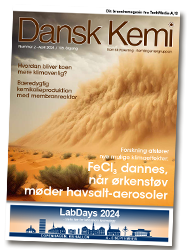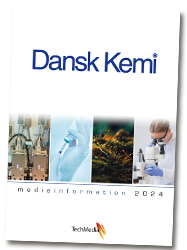Advances in chemical ionization mass spectrometry can improve our understanding of atmospheric composition.
Artiklen har været bragt i Dansk Kemi nr. 2, 2025 og kan læses uden illustrationer, strukturer eller ligninger herunder
(læs originalartiklen her)
Af Varun Kumar, Institut for Miljøvidenskab, Aarhus Universitet
The Earth’s atmosphere is composed of various human-made and natural gases and aerosols (tiny particles). A complete identification and quantification of these constituents is required to have a thorough understanding of their effects on Earth’s climate, indoor and outdoor air quality, and human health. However, the chemical characterization of these constituents is extremely challenging because of the enormously high number of species and their distinct physical and chemical properties.
Advances in mass spectrometry based techniques
Mass spectrometry-based techniques have been popular for many decades to identify substances in the atmospheric samples. Initial applications included use of gas chromatography (GC), and liquid chromatography (LC) coupled to mass spectrometers (GC-MS and LC-MS) to identify constituents of atmospheric mixtures using offline analysis [1,2].
Although these techniques are highly chemically specific, they can only resolve a fraction of species present in atmospheric samples. In addition, the usage of offline techniques is limited by the need of sample pre-treatment and their low time resolution. A major development in pursuit of real-time analysis of atmospheric aerosols came in the form of aerosol mass spectrometer (AMS) in the early 2000s [3]. This instrument samples aerosol particles in real time which are subsequently vaporized and then ionized using electron impact (EI) ionization. The ionized species are then detected by a mass spectrometer.
Although the information on bulk characteristics such as total mass of different aerosol species make this instrument highly popular and important, the use of hard ionization (EI, where 70eV electrons are bombarded on samples), however, results in high degree of sample fragmentation and hence limited molecular information can be obtained. In recent years, the advancement of mass spectrometry technology has led to developments of instruments based on soft ionization techniques capable of providing molecular level characterization of atmospheric constituents both in the gas- and particle phases in real time.
Chemical ionization mass spectrometry (CIMS) is one such technique which has stood out from other analytical techniques in the last decade and is now one of the most widely used tools for atmospheric chemistry research. Over the years, improvements in CIMS technology have made it more sensitive, faster, and accurate. These advancements help scientists measure even tiny amounts of gases and aerosols in the atmosphere at a very high time resolution (seconds to minutes), leading to a better understanding of pollution sources, chemical reactions in the air, and their impact on climate and human health.
Basics of CIMS
The basic concept of CIMS is based on ion molecule reactions (IMRs) where a reagent ion (R±) undergoes collisions with analyte molecules (A) in the gas-phase and leads to the production of a product ion (A±) which contains intact molecular structure of the analyte plus a neutral byproduct (R). The ionization of analyte A happens with minimal energy transfer and thus very limited fragmentation.
(reaktion 1)
The charged analyte ions are then focused and transported using electric fields and ion optics to a mass spectrometer (e.g., TOF, Quadrupole, Orbitrap) where they are separated based on their mass-to-charge (m/z) ratioand a mass spectrum of analyte is produced. A basic configuration of CIMS is shown in figure 1.
The high selectivity and sensitivity of CIMS lies in its ionization chemistry, which relies on reagent ions to selectively ionize target molecules via ion-molecule reactions (IMRs). The choice of reagent ion is, therefore, critical in determining the type of compounds detected. Different reagent ions have been developed in recent years to expand the range of measurable species.
The common reagent ions in positive mode include H3O+, NO+, C6H6+, C2H5OH+, NH4+, and protonated amines, while negative mode includes I–, CH3C(O)O–, CF3O–, Br–, and NO3– [5]. Reagent ions are typically generated using various sources such as radioactive ion sources (e.g., 210Po), X-ray, or vacuum ultraviolet (VUV) ion sources. Table 1 summarizes a few common reagent ions and the class of compounds they are used to detect. Please note that the list of reagent ions listed, and the examples of species detected by the respective reagent ion is not exhaustive.
Recent applications of CIMS in atmospheric chemistry research
Advancements in CIMS have enabled more precise and comprehensive measurements of various atmospheric species, including volatile organic compounds (VOCs), highly oxygenated molecules (HOMs), and organic aerosols (OA), providing deeper insights into their formation, evolution, and environmental impacts.
Detection of atmospheric VOCs from traditional and emerging sources
Volatile organic compounds (VOCs) are critical components of the Earth’s atmosphere, influencing air quality and climate. Recent development in proton transfer reaction mass spectrometry (PTR-MS), which is a widely employed type of CIMS [6], in detecting and quantifying VOCs have significantly improved sensitivity and resolution, allowing for the detection of VOCs at very low concentrations (pptv levels). These instruments have been used in both laboratory and field studies to measure VOCs from biogenic sources (e.g., forests) and anthropogenic sources (e.g., urban emissions, wildfires) [7,8].
Highly oxidized molecules (HOMs)
Highly oxygenated molecules (HOMs) are a class of organic compounds with six or more oxygen atoms, formed through autoxidation processes involving peroxy radicals (RO2•) [9]. HOMs are significant contributors to secondary organic aerosol (SOA) formation due to their low volatility. CIMS employing NO3ˉ as reagent ion (i.e., NO3ˉ-CIMS) has been widely used to study HOMs formed from the oxidation of monoterpenes, isoprene, and aromatic VOCs [10,11]. Additionally, NO3ˉ-CIMS coupled with a special inlet for aerosols i.e., (Filter Inlet for Gases and AEROsols; FIGAERO) has been used to measure particle-phase HOMs, providing insights into their role in aerosol growth and aging [12].
Real-time OA bulk and surface molecular composition
Real-time measurements of organic aerosol (OA) molecular composition are crucial for understanding aerosol formation and aging processes. Various types of CIMS techniques have been successfully deployed in both laboratory and field studies, providing near-molecular level characterization of OA. For example, extractive electrospray ionization (EESI)-MS and FIGAERO-CIMS have been used to study the molecular composition of OA [13,14] in both field and laboratory studies.
Conclusions
Chemical ionization mass spectrometry has revolutionized the study of atmospheric chemistry by providing highly sensitive and precise measurements of atmospheric aerosols and trace gases. Continuous improvements in ionization techniques, instrument design, and data analysis methods have expanded its applications, making it a critical tool for environmental monitoring, pollution control, and climate research. As technology advances, CIMS will continue to play a significant role in understanding the complex chemical processes occurring in our atmosphere, ultimately helping to improve air quality and mitigate climate change.
E-mail:
Varun Kumar: varunkm@envs.au.dk
References
1. J.D. Surratt et al., “Chemical Composition of Secondary Organic Aerosol Formed from the Photooxidation of Isoprene,” J Phys Chem A, vol. 110, no. 31, pp. 9665-9690, Aug. 2006, doi: 10.1021/jp061734m.
2. J. Warnke, R. Bandur, and T. Hoffmann, “Capillary-HPLC-ESI-MS/MS method for the determination of acidic products from the oxidation of monoterpenes in atmospheric aerosol samples,” Anal Bioanal Chem, vol. 385, no. 1, pp. 34-45, 2006, doi: 10.1007/s00216-006-0340-6.
3. J.T. Jayne et al., “Development of an Aerosol Mass Spectrometer for Size and Composition Analysis of Submicron Particles,” Aerosol Science and Technology, vol. 33, no. 1-2, pp. 49-70, 2000, doi: 10.1080/027868200410840.
4. J. Sanchez, D.J. Tanner, D. Chen, L.G. Huey, and N.L. Ng, “A new technique for the direct detection of HO_2 radicals using bromide chemical ionization mass spectrometry (Br-CIMS): initial characterization,” Atmos Meas Tech, vol. 9, no. 8, pp. 3851-3861, 2016, doi: 10.5194/amt-9-3851-2016.
5. W. Zhang, L. Xu, and H. Zhang, “Recent advances in mass spectrometry techniques for atmospheric chemistry research on molecular-level,” Mass Spectrom Rev, vol. 43, no. 5, pp. 1091-1134, 2024, doi: https://doi.org/10.1002/mas.21857.
6. B. Yuan, A.R. Koss, C. Warneke, M. Coggon, K. Sekimoto, and J.A. de Gouw, “Proton-Transfer-Reaction Mass Spectrometry: Applications in Atmospheric Sciences,” Chem Rev, vol. 117, no. 21, pp. 13187-13229, Nov. 2017, doi: 10.1021/acs.chemrev.7b00325.
7. Y. Liang et al., “Emissions of organic compounds from western US wildfires and their near-fire transformations,” Atmos Chem Phys, vol. 22, no. 15, pp. 9877-9893, 2022, doi: 10.5194/acp-22-9877-2022.
8. A.R. Koss et al., “Non-methane organic gas emissions from biomass burning: identification, quantification, and emission factors from PTR-ToF during the FIREX 2016 laboratory experiment,” Atmos Chem Phys, vol. 18, no. 5, pp. 3299-3319, 2018, doi: 10.5194/acp-18-3299-2018.
9. F. Bianchi et al., “Highly Oxygenated Organic Molecules (HOM) from Gas-Phase Autoxidation Involving Peroxy Radicals: A Key Contributor to Atmospheric Aerosol,” Chem Rev, vol. 119, no. 6, pp. 3472-3509, Mar. 2019, doi: 10.1021/acs.chemrev.8b00395.
10. M. Ehn et al., “A large source of low-volatility secondary organic aerosol,” Nature, vol. 506, no. 7489, pp. 476-479, 2014, doi: 10.1038/nature13032.
11. U. Molteni et al., “Formation of highly oxygenated organic molecules from aromatic compounds,” Atmos Chem Phys, vol. 18, no. 3, pp. 1909-1921, 2018, doi: 10.5194/acp-18-1909-2018.
12. A. Mutzel et al., “Highly Oxidized Multifunctional Organic Compounds Observed in Tropospheric Particles: A Field and Laboratory Study,” Environ Sci Technol, vol. 49, no. 13, pp. 7754-7761, Jul. 2015, doi: 10.1021/acs.est.5b00885.
13. V. Kumar et al., “Highly time-resolved chemical speciation and source apportionment of organic aerosol components in Delhi, India, using extractive electrospray ionization mass spectrometry,” Atmos Chem Phys, vol. 22, no. 11, pp. 7739-7761, 2022.
14. J. Cai et al., “Characterization of offline analysis of particulate matter with FIGAERO-CIMS,” Atmos Meas Tech, vol. 16, no. 5, pp. 1147-1165, 2023, doi: 10.5194/amt-16-1147-2023.

